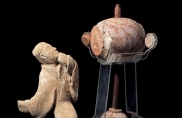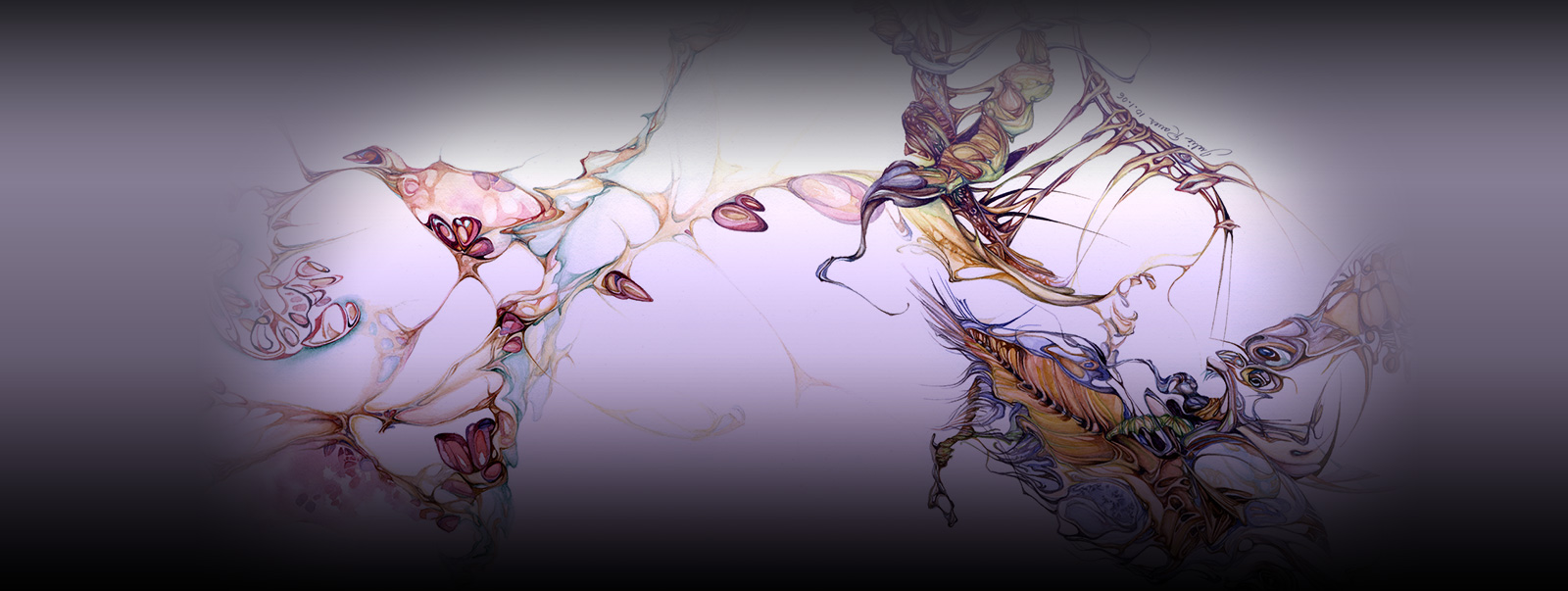“Winter worm, summer grass”, lyrical designation for the ancient Chinese ingredient dong chong xia cao, is the epitome of medicinal gastronomy, singular cultural invention of a civilization which pioneered the use of food as tonic, evolving a complex palliative cuisine lush with aesthetic manifestation, yet constructed on the pragmatic foundations of pharmacopoeic scholarship. Peeling away the euphemisms of seasonal poetry, the aforementioned item, figuring prominently in both an aromatic soup nestled amongst black chicken segments, onion, garlic, and chili pepper—and as a potent curative tea—is actually caterpillar fungus.
Relentless predator of the ghost moth larvae, Cordyceps sinensis, ingested by the Chinese nobility to much curative acclaim for over three thousand years, is still a highly prized delicacy, exorbitantly priced at 4,000 yuan, or $500 U.S. per pound. Tonic of lords and sovereigns, caterpillar fungus was reputedly utilized by King Zheng, the First Emperor (Shi huangdi), in his quest for longevity. This parasitic fungus literally acts as a body snatcher, invading the caterpillar from head to stern while growing deep into the creature’s flesh—in the fashion of a strangler fig, comparably ravenous botanical marauder—eventually creating a hard, umber fungal doppelganger of the original caterpillar by systematically replacing all of its bodily tissues.
Brewed as a beverage, the consumption of fungus was committed to writing with particular eloquence during the year 200 B.C. in the Yangsheng Fang, or “Recipes for Nurturing Life”, a recipe manual—with eighty-seven exquisitely detailed preparations revolving around food as virility and longevity tonic—for macrobiotic hygiene in the Mawangdui medical manuscripts. Unearthed in 1973 from tomb 3 at Mawangdui, located in the northeastern section of Changsha, Hunan, the complete manuscript corpus consists of thirty manuscripts (twenty-eight of which are transcribed on silk, noteworthy for its rarity, as most other manuscripts found were written on far less costly bamboo or wood) and forty-five texts. With only one exception, a manuscript dating to the Warring States period from another tomb, these texts, enclosed in a rectangular lacquer box, are the earliest Chinese writings on silk discovered.
Languishing in darkness 17.7 meters beneath daylight, deep in a wooden burial chamber dating to 168 B.C., encased in three internested coffins, lay the inscribed ‘master of the tomb’, most likely Li Xi, the thirty year old son of Li Cang, Marquis of Dai. Surrounded in death by all of the elaborate trappings and pragmatic conveniences of life deemed essential by the ancient Chinese to ensure a comfortable afterlife, Li Xi was encircled by a vast quantity of grave goods provided for his future welfare; four storage areas yielded a staggering archaeological trove of three hundred and sixteen pieces of lacquer ware, including numerous pan dishes (fig. 2, below) suitable for food service, and a cornucopia of immaculately prepared and refined dishes, accompanied by vessels filled with exceedingly well preserved raw comestibles awaiting consumption by the p’o, the soul’s earthly component.
According to Han dynasty philosophy defining death—separation of both aspects of the soul from the body—the hun, or ethereal component leaves the corpse and ascends through heavenly realms to the kingdom of immortals, while thep’o, grounded grave-dwelling portion of the human soul, must be discouraged from abandoning the body via appeasement by tomb furnishings resplendent with all manner of material goods, earthly possessions emblematic of status (figs.3 and 4, above) and luxury, services and foods. Mingqi, “glorious vessels” or objects crafted for burial with the dead, filled Han tombs, which pulse eerily in highly detailed imitation of life: replicas of green glazed earthenware farmyards (fig. 9, below), pigsties, domesticated animals (fig. 10, below), servants, musicians, and, of course, grinning chefs ready to serve. Fish and fowl cavort in an enchanting square duck pond (fig. 11, below), a Han period earthenware treasure at Berwald Oriental Art, a New York City gallery with a superlative collection of mingqi.
Mortuary pottery also took the form of the inanimate, mimicking familiar structures and objects necessary in daily life: wellheads with functional pulley and bucket systems (fig. 12, below), pestling shops, multistoried edifices, and the particularly noteworthy pottery granaries (fig.13, below) and stoves, which were amongst the earliest mingqi to appear, achieving great popularity in the middle Western Han, and subsequently declining thereafter. Miniature chefs creating delicacies for the deceased on Lilliputian stoves (fig. 14 and 15, below) happily links epicureanism with death, inextricably bound together in spheres of Han thought, with satiety of vital importance before and beyond the grave. Uniquely weaving the subtleties of food preparation and consumption through the substance of both life and afterlife, the act of eating achieved mythic dimensions while raw provisions, elevated to the status of perpetual sustenance, fed an eternal cuisine.
Guidance and instruction—in keeping with the Han ideology of ensuring smooth continuation of natural cycles and definitive paths for human destiny—assured Li Xi of a stable, lucid afterlife anchored to the gastronomically familiar, the essential dietary regime embodied by the recipe cures that defined ancient Chinese cuisine with its conjoined role as both nutriment and medicine.
Nurturing the second Lord of Dai, Li Xi, in the next world are two viscerally fascinating recipes (both contained in MS III of the Mawangdui Medical Manuscripts, “Recipes For Nurturing Life”, which, while remarkably complete, have suffered some damage evidenced by breaks in the text – indicated below by —-) utilizing, with much certainty, the renowned Caterpillar fungus, Cordyceps sinensis, telescoping epicurean link between ancient and modern cuisines. The first recipe fosters health in the interior realms of the human body:
“Another. To cultivate the inside. Collect bulging fungi that have just started to bulge forth, and dry them in the dark [without] letting them see the daylight. Wait until they are dry. —- take five bai (described as a grain-like plant) —-, twomendong (most probably refers, according to Donald J. Harper in Early Chinese Medical Literature, to mai mendong, a drug from plants in the genus Liriope), and one fuling (pine truffle). Then pestle them together. Soak in water, using just enough to cover. —- and press to obtain the liquid. Use it to soak the bulging fungi, again using just enough to cover. Then remove and dry them. Let them become completely dry, then smith. Drink a three-fingered pinch in one half cup of –”
Physical endurance is the primary objective of the other Mawangdui manuscript caterpillar fungus recipe, culled from the recipe section addressing pedestrian travel—aiming to not only quicken one’s pace, but also to heighten stamina on long journeys:
“Striding. Feilan (either refers to thistle, or, more curiously, to flying cockroach), fangkui, shiwei (pyrrosia), jiegeng(balloon flower), and ziwei (trumpet-flower), one small bunch each; wuhui (monkshood), three nodules; —- large —- bamboo skin, five cun; bai tengshe (possibly python bile) or zang gengshe that is three to four cun long, or —-. Smith separately, and combine with —- or zao (jujube) fat to make balls the size of sheep feces. Eat once every fifty li. Dark fungus comes from Luo —-. Seven hundred (likely the number of li one can traverse in a single day after consuming these potent medicine balls).”
Yet many of the remarkable recipe manuscripts, lacquers, and food vessels discovered in Li Xi’s tomb were badly damaged just after 168 B.C. by the construction and eternal installation of a formidable presence in Mawangdui’s largest vertical-shaft tomb 1—his mother, the Marchioness of Dai. Sequestered inside four nested coffins, beneath a stratum of charcoal and another of white clay, cocooned in twenty layers of garments bound with silk ribbons, Lady Dai (Xi Zhui, wife of the Marquis of Dai, Li Cang) was revealed in a flawless state of preservation, saved from bacterial degradation and decay, her skin still supple and internal organs, muscles, and viscera all intact, moist, and stunningly elastic. Reputedly a beauty in her younger days, the fifty year old Marchioness ate a wide and resplendent path through decades of sedentary luxury, indulging every culinary whim to leave a diminutive frame buckling under obesity. A double chin is easily discernable in photographs of the body. Black hair persists in a feral nest encircling her face, a portly visage forever halted in an open-mouthed pantomime of uninterrupted mastication. Type A blood still lingers in her veins.






COMMENTS
There are no comments yet!